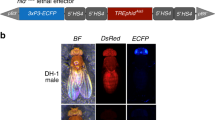Abstract
Chromosomal recombination suppressors (RS) were induced and studied as part of a programme to induce and isolate temperature-sensitive recessive lethal factors, for subsequent use in genetic sexing mechanisms in the medfly, Ceratitis capitata (Wied.).
The presence of induced RS factors was identified through the complete linkage of two morphologicla markers, ap and dc, located 18.25 recombination units apart. Adult +dc males were irradiated one day after emergence with 50 Gy in a cobalt-60 source. The irradiated males were mated to marked ap + females and the F1 females were crossed to ap dc males. A total of 5 heterozygous RS factors was isolated from 570 irradiated and screened chromosomes. Suppression of female recombination in the heterozygous lines ranged from 77.6% in RS 19 to 99.1% in RS 30B. Chromosomal analysis showed all RS lines to contain a single reciprocal translocation involving in all cases chromosome 3 and one other autosome. It appears that recombination between the two morphological markers is suppressed either through lethality conferred upon the gametes, which results from recombinant events taking place in the interstitial segment between the centromere and the translocation breakpoints, or through interference by the translocation heterozygote with the initiation or maintenance of cross-over synapsis thus preventing the appearance of cross-over products.
All 5 translocations involved chromosome 3 and one of the other autosomes, providing the first evidence for a correlation between the ap-dc linkage group and chromosome 3.
Similar content being viewed by others
References
Baker, R. H., Sakai, K. S. & Saifuddin, U. T., 1977. Pericentric inversions on chromosome 2 in Culex tritaeniorhynchus. Mosq. News 37: 681–688.
Bedo, D., 1986. Polytene and mitotic chromosome analysis in Ceratitis capitata (Diptera: Tephritidae). Can. J. Genet. Cytol. 28: 180–188.
IAEA, 1982. Sterile insect technique and radiation in insect control. Proceedings of an IAEA/FAO symposium. Neuherberg, FRG, 29 June–3 July 1981, 499 pp.
IAEA, 1983. Report on research co-ordination meeting on the development of sexing mechanisms in fruit flies through manipulation of radiation-induced lethals and other genetic measures. Joint FAO/IAEA Division, Vienna, Austria, March 1983 (mimeographed).
Lifschitz, E., Manso, F., Cladera, J. & Fauret, E. A., 1983. Genetic sex-sorting mechanisms for the Mediterranean fruit fly. In: Report on research co-ordination meeting on the development of sexing mechanism in fruit flies through manipulation of radiation-induced lethals and other genetic measures. Joint FAO/IAEA Division, Vienna, Austria, March 1983 (mimeographed).
Radu, M., Rössler, Y. & Koltin, Y., 1975. The chromosomes of the Mediterranean fruit fly Ceratitis capitata (Wied.). Karyo-type and chromosomal organisation. Cytologia 40: 823–828.
Roberts, P. A., 1970. Screening for X-ray-induced corss-over suppressors in Drosophila melanogaster: prevalence and effectiveness of translocations. Genetics 65: 429–448.
Robinson, A. S. & Van, Heemert, C., 1982. Ceratitis capitata, a suitable case for genetic sexing. Genetica 58: 229–237.
Robinson, A. S., Cirio, U., Hooper, G. H. S. & Capparella, M., 1986. Field cage studies with a genetic sexing strain in the Mediterranean fruit fly, Ceratitis capitata. Ent. exp. appl. studies 41: 231–235.
Rössler, Y. & Koltin, Y., 1976. The genetics of the Mediterranean fruit fly, Ceratitis capitata: three morphological mutations. Ann. ent. Soc. Am. 69: 604–608.
Rössler, Y., 1979. The genetics of the Mediterranean fruit fly: a “white pupae” mutant. Ann. ent. Soc. Am. 72: 583–585.
Rössler, Y., 1982. Genetic recombination in males of the Mediterranean fruit fly, and its relation to automated sexing methods. Ann. enz. Soc. Am. 75: 28–31.
Saul, S. H., 1985. Diagnosing the heterogametic sex in the Mediterranean fruit fly (Diptera: Tephritidae): the first sex-linked gene. Ann. ent. Soc. Am. 78: 198–200.
Southern, D. I., 1976. Cytogenetic observations in Ceratitis capitata. Experientia 32: 20–22.
Strickberger, M. W., 1976. Genetics (2nd edition). Macmillan, New York, 914 pp.
Zapater, M. & Robinson, A. S., 1986. Sex chromosome aneuploidy in a male-linked translocation in Ceratitis capitata. Can. J. Genet. Cytol. 28. 161–167.
Author information
Authors and Affiliations
Rights and permissions
About this article
Cite this article
Busch-Petersen, E., Southern, D.I. Induced suppression of genetic recombination in females of the Mediterranean fruit fly, Ceratitis capitata (Wied.), by translocation heterozygosity. Genetica 72, 161–169 (1987). https://doi.org/10.1007/BF00116219
Received:
Accepted:
Issue Date:
DOI: https://doi.org/10.1007/BF00116219




